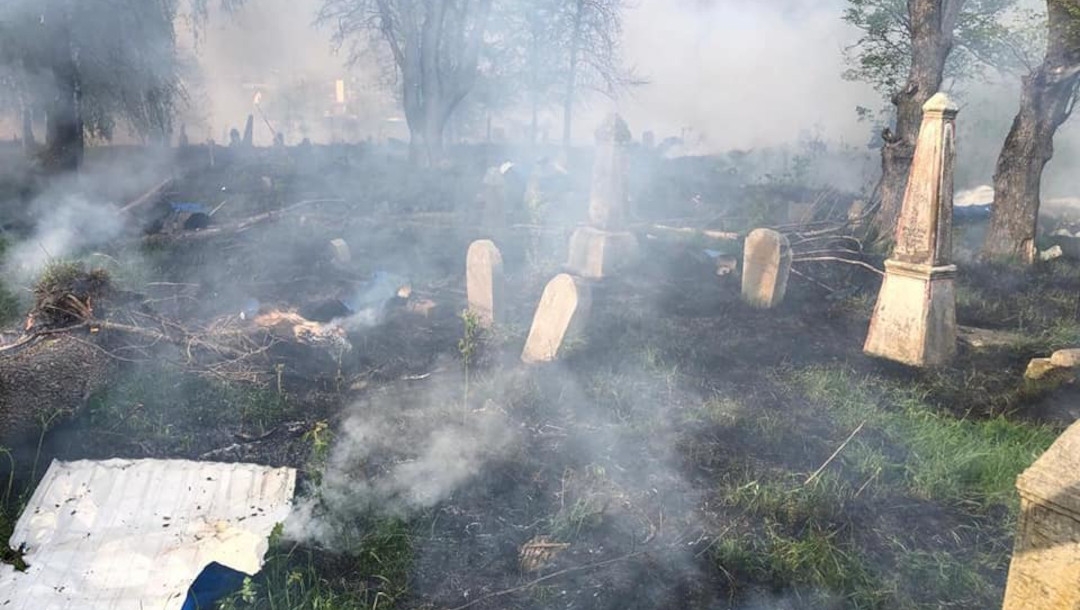Russian shelling damages Jewish cemetery in Ukraine where pogrom victims are buried
At least 105 of the hundreds of people buried at the graveyard in Hlukhiv died in a 1918 pogrom.

Smoke billows among headstones of a Jewish cemetery that reportedly was bombed in Hulkhiv, Ukraine, May 8, 2022. (Dmitry Zhivitsky / Facebook)
(JTA) — A Jewish cemetery in Hlukhiv, Ukraine, was reportedly shelled Sunday in fighting close to the Russian border.
The cemetery, where about 1,500 Jews are buried, is the latest Jewish site to face damage amid the 10-week-old war that began when Russia invaded Ukraine Feb. 24.
Many of the Jews buried in the cemetery were victims of a 1918 pogrom. Among them are Samuel Nokhimovich Shumyatsky, an older brother of a well known rabbi, and a shochet, or butcher, named Ber Izrailevich Barkan, according to Ukraine’s Kourier news site.
Ukrainian Minister of Culture Oleksander Tkachenko said in a statement that influential rabbis were also buried in the cemetery.
“This is not only a monument to history, it is a special symbol for the entire Jewish people,” Ukrainian Minister of Culture Oleksander Tkachenko said in a statement. “The proof that all the higher powers are on our side is that the graves of the chief tsadik [Hasidic spiritual leader] have survived.”
In the past, Jewish sites that have been damaged by Russian shelling have become symbols for the Ukrainians, who are battling the Russians’ false claim that their country is run by Nazis. In the early days of the war, Ukrainian President Volodymyr Zelensky, who is Jewish, highlighted damage to a memorial for Jews murdered by the Nazis and local collaborators at Babyn Yar, as well as shelling in Uman, a Jewish pilgrimage site, as evidence that Russian forces are trying to obliterate Ukrainian history.
At least one other Holocaust memorial, on the outskirts of Kharkiv, was damaged in the war. Meanwhile, the Hillel in Kharkiv, housed in a historic building in that city’s center, was destroyed early on as well.
The sites have not appeared to have been deliberately targeted but have fallen victim to indiscriminate shelling as part of Russia’s shifting campaign to control regions of Ukraine.
The pogrom in Hlukhiv, also known in Russian as Glukhov, was part of a series of such events perpetrated during the 1917-1923 Russian Revolution, where some Czarist nationalists and others regarded Jews as a hostile force. State records speak of at least 105 victims in the Hlukhiv pogrom, though reports in the media at the time spoke of several hundred fatalities.
One historian wrote in 1923 about the 1918 pogrom in Hlukhiv: “Blood flowed in the river, they shot at the synagogue and tore the Torah.”
This story originally appeared on JTA.org.
A message from our CEO & publisher Rachel Fishman Feddersen
I hope you appreciated this article. Before you go, I’d like to ask you to please support the Forward’s award-winning, nonprofit journalism during this critical time.
We’ve set a goal to raise $260,000 by December 31. That’s an ambitious goal, but one that will give us the resources we need to invest in the high quality news, opinion, analysis and cultural coverage that isn’t available anywhere else.
If you feel inspired to make an impact, now is the time to give something back. Join us as a member at your most generous level.
— Rachel Fishman Feddersen, Publisher and CEO